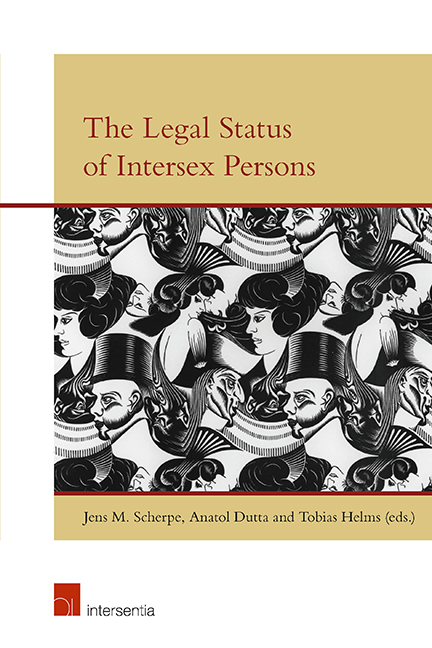Book contents
- Frontmatter
- Preface
- Contents
- List of Contributors
- The Legal Status of Intersex Persons: An Introduction
- Malta Declaration
- Darlington Statement
- Vienna Statement
- PART I MEDICINE AND PSYCHOLOGY
- PART II THEOLOGY AND LEGAL HISTORY
- PART III TRANSGENDER, TRANSSEXUALITY AND INTERSEX
- PART IV NATIONAL LEGAL DEVELOPMENTS
- Australia
- Sweden
- India
- The Netherlands
- France
- Colombia (The Colombian Constitutional Court)
- United States
- Malta
- Germany (The 2013 German Law)
- Germany (German Inter-Ministerial Working Group)
- Germany (Gender Diversity in Law)
- PART V PRIVATE INTERNATIONAL LAW ASPECTS OF INTERSEX
- PART VI INTERSEX AND HUMAN RIGHTS
United States
from PART IV - NATIONAL LEGAL DEVELOPMENTS
Published online by Cambridge University Press: 31 January 2019
- Frontmatter
- Preface
- Contents
- List of Contributors
- The Legal Status of Intersex Persons: An Introduction
- Malta Declaration
- Darlington Statement
- Vienna Statement
- PART I MEDICINE AND PSYCHOLOGY
- PART II THEOLOGY AND LEGAL HISTORY
- PART III TRANSGENDER, TRANSSEXUALITY AND INTERSEX
- PART IV NATIONAL LEGAL DEVELOPMENTS
- Australia
- Sweden
- India
- The Netherlands
- France
- Colombia (The Colombian Constitutional Court)
- United States
- Malta
- Germany (The 2013 German Law)
- Germany (German Inter-Ministerial Working Group)
- Germany (Gender Diversity in Law)
- PART V PRIVATE INTERNATIONAL LAW ASPECTS OF INTERSEX
- PART VI INTERSEX AND HUMAN RIGHTS
Summary
INTRODUCTION
United States citizens typically possess a number of government-issued identity documents that contain a sex indicator. These documents may include a federally issued passport, a state-issued drivers ‘licence and a birth certificate that may be issued by the state, county or city where the person was born. Each government entity issuing these documents operates independently and is governed by diff erent statutes, rules and regulations. Therefore, people who are transgender, intersex, or do not identify as either male (M) or female (F) may possess identity documents with inconsistent gender indicators.
Although transgender people have challenged legal restrictions on their ability to change an M to an F or an F to an M on their identity documents for decades, people who do not identify as either M or F have only recently challenged the rules limiting the gender indicator to the binary classifications of only M and F. In 2016, a few individuals who identify as neither male nor female sought court orders allowing them to be legally recognised as a sex other than male or female. Many of the challenges have been successful, but court recognition of a non-binary sex marker has not led to abandonment of the binary system by state and federal agencies responsible for issuing and amending identity documents.
The current patchwork quilt US system, under which intersex people and people who do not identify within the binary sex classifications may have an M on one official document, an F on another, and an X/I on a third document, will likely remain intact until a court determines that denying someone the right to identify as something other than M or F is unconstitutional.
This chapter discusses the legal challenges that people who identify as neither male nor female have brought and examines the legal limitations on the ability to use a court order affirming someone's sex as non-binary to obtain amended identity documents. It then discusses the constitutional ramifications of denying someone the ability to identify as neither male nor female and concludes that government agencies that deny people the ability to self-identify as a sex other than male or female likely violate the United States Constitution's equal protection and substantive due process guarantees.
- Type
- Chapter
- Information
- The Legal Status of Intersex Persons , pp. 339 - 356Publisher: IntersentiaPrint publication year: 2018
- 2
- Cited by

